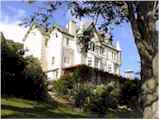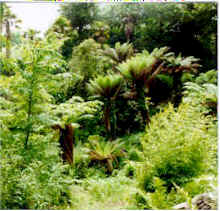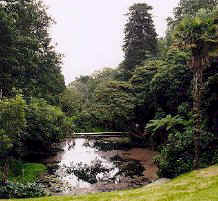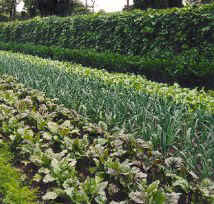The Lost Gardens of Heligan, Cornwall
OPEN EVERY DAY OF THE YEAR
(except Christmas Eve & Christmas Day)
Main season:- 10.00 a.m. to 6.00 p.m. (last tickets at 4.30 pm)
Winter:- 10.00a.m. to 5.00 p.m.
- Background
- These gardens, near Mevagissy in Cornwall, have been restored and well marketed
by Tim Smit. They have had a four part TV series on channel 4 in 1997, there
is a best selling book on the "Heligan story", and there have been
countless newspaper articles.
- .
- They comprise eighty acres of pleasure grounds plus a complex of walled
gardens and a huge vegetable garden. The house, built by William Tremayne
in 1603, was the seat of the Tremayne family who controlled over 1000 acres
in the area from Pentewan to Gorran. This Estate was totally self sufficient,
having a number of quarries, woods, farms, a brickworks ( the earliest
in Cornwall in 1681), a flour mill, a sawmill, a brewery, and productive orchards
and gardens. It is the gardens that are now claimed to be the site of the
largest garden restoration in Europe. Heligan House (meaning "the willows"
in Cornish ), was the Tremayne's seat, but is not part of the gardens project.
-
- The gardens, created mainly in the 19th century, of were one of the finest
gardens in England of their period, with 57 acres of planted gardens, around
100 acres of ornamental woodlands, and 300 acres of rides. Scattered throughout
were follies and temples. Henry Hawkins Tremayne, John Tremayne and John Claude
Tremayne in turn created and planted the gardens and ornamental woodlands
with walks and rides. They were noted botanists and horticulturists and by
the 1900 had a amassed a wonderful collection of trees and shrubs from all
over the globe, many of which can be seen today. It was the centre of
the community with 20 house staff and up to 22 garden staff, with the local
economy dependent on the estate for their income and parishes assisted by
the Tremaynes benevolence.
-
- When World War I started in 1914, the male staff all signed up with
the Duke of Cornwall's Light Infantry, with whom they served in the mud and
trenches of the Western Front. Heligan House was taken over by the War Office
and became a convalescent home for officers for the duration of the war. In
the in the gardeners toilet or "thunderbox room." has been scratched
into the plaster on the day that World War I broke out, the message "Come
ye not here to sleep or slumber" and underneath it all the garden staff
signed their a names.
-
- At the end of the war only around 6 of the 22 garden staff survived the
battles in Flanders to return to Heligan. The house was returned to the family
in 1919. In the changed post war world the Tremaynes were not able to keep
such a large staff, and decided in 1920 to rent the house out. The Williamson
family rented it, were unable to maintain the gardens, which went on a gradual
decline.
-
- In World War II, the US army were allocated the house. Practice landings
for D-Day took place on Pentewan Beach, a mile away. And after the war the
next tenants were Commander and Mrs. Thomas, who lived there until 1970, when
the tremaynes sold the house as flats. The gardens remained in the ownership
of the Tremaynes, but nothing was done to them. They remained a time capsule,
as they were not altered by any modernisation
- There is a plant collection, a range of exotic glasshouses, and various
buildings and landscaping that reflect the interests of the family in the
past. The gardens were lost for many years under mountains of ivy, bramble
and laurel. I know from experience in our own lost garden at Corisande that
these weeds grow extraordinarily quickly in Cornwall.
-
- Then in February 1990, a chance meeting between the Tremayne family member
who had inherited the gardens (a John Willis) and Tim Smit and John
Nelson changed the history and direction of Heligan's gardens. Smit and Nelson
got a lease on the gardens, researched their history, and raised money to
restore the area.. A joint venture was established between
the freeholder (a small Estate Company owned by the trustees of the Tremayne
interests) and an operating company (controlled by Tim Smit and colleagues,
including John Nelson supervisor of the works.)
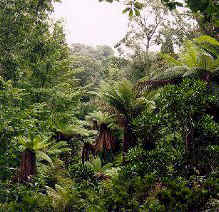

- The Pleasure grounds
- The pleasure grounds house rare and exotic shrubs, collected by plant hunters,
from all over the world in the 19th century. There are lots of parts to the,
the Northern Summerhouse with its sea views, the Italian Garden, the Fern
Ravine, the Wishing Well, one of the finest beehole walls in the country and
the Crystal grotto whose interior was lit by candles for romantic summer evenings.
-
- Recently opened in 1997 is the walled sundial garden. And there is the vast
herbaceous border described as the finest in England in Victorian times.
-
- The 1839 tithe map has been used to restore the Ornamental garden paths.
Two and a half miles of foot paths were discovered underneath more than 2000
tons of fallen timber, 18 inches of loam and a complete covering of 10 foot
high brambles.
-
- In the Northern Gardens you will find
- Flora's Green, a lawn used by the ladies for dancing, and surrounded
by a collection of Rhododendrons brought back from the Himalayas between 1847
to l 849 by the famous plant collector Sir Joseph Hooker. The Green
now has what is believed to be the largest Rhododendron in the world, measuring
82 feet from bowl to tip. .
- The Ravine, a rockery more than 100 yards long.
- The Vegetable Garden, two and a half acres of kitchen garden to supply the
house
- The Melon Garden, an oval walled garden containing pineapple pits, melon
frames, bothys. Built about 1720, the Melon House was heated by a boiler with
pipes running under the beds. It now being used once again to produce melons
and cucumbers. Its south facing wall grows pears, apricots, cherries and plums.
- While the pineapple pit near it was heated by an eclectic mix of fermenting
bark and horse manure. This is the only working Georgian pineapple pit in
Europe. The Pineapples are the original species used, being acquired
from the agricultural research station of East London, near Durban in South
Africa. The first of the modern pineapples grown in this way was presented
to the Queen.
- The Italian Garden with its summer house and formal pool was inspired by
the discoveries being made at Herculaneum and Pompeii at the time they
were created.
- The Sundial Garden was described in 1896 Gardener's Chronicle as the
finest herbaceous border in England;
- The Georgian Walled flower Garden with has a Vine house, peach and fig houses
and a dipping pool;
- The Bee-boles is a large wall with 15 vaulted chambers to house bees - the
forerunner of modern beehives - bees were very important to gardens as they
pollinated the plants and supplied honey and wax
- The Dell, contains tree ferns, a superb Ginkgo tree, a Wishing Well and
Crystal Grotto;
- The Northern Summer House with its panoramic view over St. Austell Bay;
The St Michael's Mount. It is unsure when this was built , but there is a
reference to it in 1623 when mentioned as the old beacon.
- There are some outstanding specimen trees at Heligan, among the most
remarkable are the World's largest Japanese Black Pine (Pinus thumberg),Chinese
Cedar (Cedrella sinensis), and Chilean Yew (Podocarpus totara).
-
- The Vegetable, flower and fruit gardens
- Four walled gardens, complete with glasshouses, frames and pits, produced
the flowers, fruit and vegetables for the Big House. Today Heligan once again
produces over 300 varieties of fruit and vegetables. The melon garden even
has a manure heated pineapple pit (quite naturally the only one remaining
in the country). the glasshouses produce citrus fruit, grapes and peaches.
-
- Also renovated have been the working side of the garden, the boiler houses,
potting sheds, fruit stores and dark houses.
-
- The Jungle
- The Big House looks down the valley which eventually winds its way to the
fishing village of Mevagissy. The Jungle was created to house a collection
of sub tropical plants. A craze for collecting these exotic plants swept the
country in the mid 1800's. This sort of sheltered valley, in Cornwall's mild
climate, was ideal for housing such delicate plants. A series of four linked
ponds, one above the other, has the plants grouped round them. Board walks
have been created for the visitors to view these specimens without destroying
the habitat. This is now the largest collection of Palms and Tree Ferns in
the British Isles. Only in the frost-free valleys of Cornwall could this passion
fulfil its promise. The boardwalks through this magnificent valley will take
you on a journey far from our temperate shores.
-
- The Lost Valley
- The latest in the string of restorations. The area has a history of charcoal
burning and Georgian rides, with a water meadow and restored lakes. Work is
continuing in this area.
It was opened to visitors in 1998 to visit this native Cornish woodland
- a circular walk of an extra mile now incorporates the Medieval Sunken
Lane and additional sections of the original Georgian Ride.
-
- Visitors
- Since it opened, visitors have flocked to Heligan, and by 1995 it became
the most visited private garden in Britain with over 200,000 visitors. It
also won the "Country Life" Garden of the Year award 1995
.
Return to Cornwall Homes & Gardens page
Cornwall Tourist Information
Cornwall Calling front page
The hotel to stay at when
visiting Cornwall is Corisande
Manor Hotel, Cornwall find out more about it
